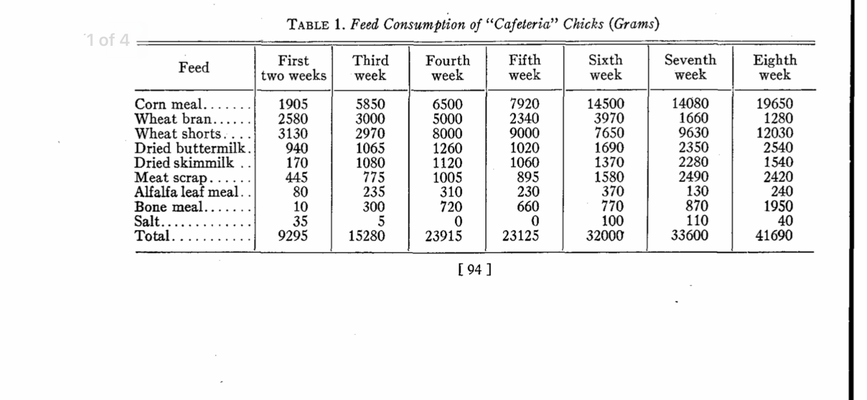Since many people are now experimenting with supplementing their chickens' diets, or even making their own feed, but often are not sure what should be in it, I thought it might be useful to transcribe some recipes from Leonard Robinson Modern Poultry Husbandry, published in 1948, and based on data and practices in the years between the two world wars, when poultry farmers made their own rations. All measures are British Imperial. Google convert will turn them into whatever measures you like.
Layers' mash 1, for stock on grass range:
20 lb bran
40 lb wheat middlings [a by-product of wheat milling, like bran; this is the 2nd layer of the grain; it should contain much of the wheat germ]
20 lb yellow maize (corn) meal
10 lb ground oats
10 lb meat-and-bone meal or fish meal
1/2 lb common salt
Layers' mash 2, for stock on grass range:
25 lb bran
40 lb fine middlings
25 lb yellow maize (corn)
5 lb extracted soya-bean meal or earth-nut (peanut) meal
5 lb meat-and-bone meal or fish meal
1/2 lb common salt
Battery-layers' mash, for birds reared in total confinement (all mash ration):
6 lb alfalfa meal or dried grass meal
20 lb bran
32 lb yellow maize (corn) meal
25 lb fine middlings
10 lb ground oats
6 lb meat-and-bone meal
1/2 lb common salt
1 pint cod-liver oil
with oyster shell or limestone grit sprinkled over the mash or 5% limestone flour added to it.
These recipes are preceded by the following remarks:
A ration that may give an entirely satisfactory result when fed to birds on free range may be, and very probably would be, inadequate for birds kept in total confinement... Balancing the ration does not imply simply the provision of a given proportion of proteins, carbohydrates, minerals and vitamins. It is possible to construct a ration in which all the essential food constituents are present in the proper proportion, and yet it would fail on account of unpalatability, low digestibility or unsuitable physical condition...birds do not relish finely ground meals, particularly when they are fed in a dry state. Very fine meals may clog the beak, causing necrosis. They also tend to form a solid mass in the digestive tract...such meals should be mixed with bran, dried grass or other bulky foodstuffs... When compounding mashes the quality of the several constituents is a matter of great importance. The formula is not the only matter to consider. By using inferior ingredients a mash may be made totally unsuitable...the value of a formula may be completely destroyed by the inclusion of poor-quality foods. Every poultry-keeper should learn to judge foodstuffs. They should be able to distinguish between the good, the bad and the indifferent.
There are further recipes for chick mashes, growers' mashes, a breeders' mash, and fattening mashes, plus some further ones where home-grown feeding stuffs are available, and a couple based on potatoes that were developed during war time, when grains were in short supply. I may add these in due course if there is interest.
Layers' mash 1, for stock on grass range:
20 lb bran
40 lb wheat middlings [a by-product of wheat milling, like bran; this is the 2nd layer of the grain; it should contain much of the wheat germ]
20 lb yellow maize (corn) meal
10 lb ground oats
10 lb meat-and-bone meal or fish meal
1/2 lb common salt
Layers' mash 2, for stock on grass range:
25 lb bran
40 lb fine middlings
25 lb yellow maize (corn)
5 lb extracted soya-bean meal or earth-nut (peanut) meal
5 lb meat-and-bone meal or fish meal
1/2 lb common salt
Battery-layers' mash, for birds reared in total confinement (all mash ration):
6 lb alfalfa meal or dried grass meal
20 lb bran
32 lb yellow maize (corn) meal
25 lb fine middlings
10 lb ground oats
6 lb meat-and-bone meal
1/2 lb common salt
1 pint cod-liver oil
with oyster shell or limestone grit sprinkled over the mash or 5% limestone flour added to it.
These recipes are preceded by the following remarks:
A ration that may give an entirely satisfactory result when fed to birds on free range may be, and very probably would be, inadequate for birds kept in total confinement... Balancing the ration does not imply simply the provision of a given proportion of proteins, carbohydrates, minerals and vitamins. It is possible to construct a ration in which all the essential food constituents are present in the proper proportion, and yet it would fail on account of unpalatability, low digestibility or unsuitable physical condition...birds do not relish finely ground meals, particularly when they are fed in a dry state. Very fine meals may clog the beak, causing necrosis. They also tend to form a solid mass in the digestive tract...such meals should be mixed with bran, dried grass or other bulky foodstuffs... When compounding mashes the quality of the several constituents is a matter of great importance. The formula is not the only matter to consider. By using inferior ingredients a mash may be made totally unsuitable...the value of a formula may be completely destroyed by the inclusion of poor-quality foods. Every poultry-keeper should learn to judge foodstuffs. They should be able to distinguish between the good, the bad and the indifferent.
There are further recipes for chick mashes, growers' mashes, a breeders' mash, and fattening mashes, plus some further ones where home-grown feeding stuffs are available, and a couple based on potatoes that were developed during war time, when grains were in short supply. I may add these in due course if there is interest.
Last edited:




